The document provides an overview of next generation networks and their components. It describes four typical network types:
1. An evolved ISP that provides telephone, video on demand, and standard ISP services through an IP Multimedia Subsystem (IMS).
2. A former telecom operator that allows VoIP subscribers to communicate with PSTN subscribers through a soft switch connected to the IMS and PSTN.
3. A 3GPP mobile network operator that offers similar services as wireline operators through an IMS accessed by UTRAN or GERAN networks.
4. A potential WIMAX network operator that functions as both a wireless network and evolved ISP, accomplishing IMS functions through SIP

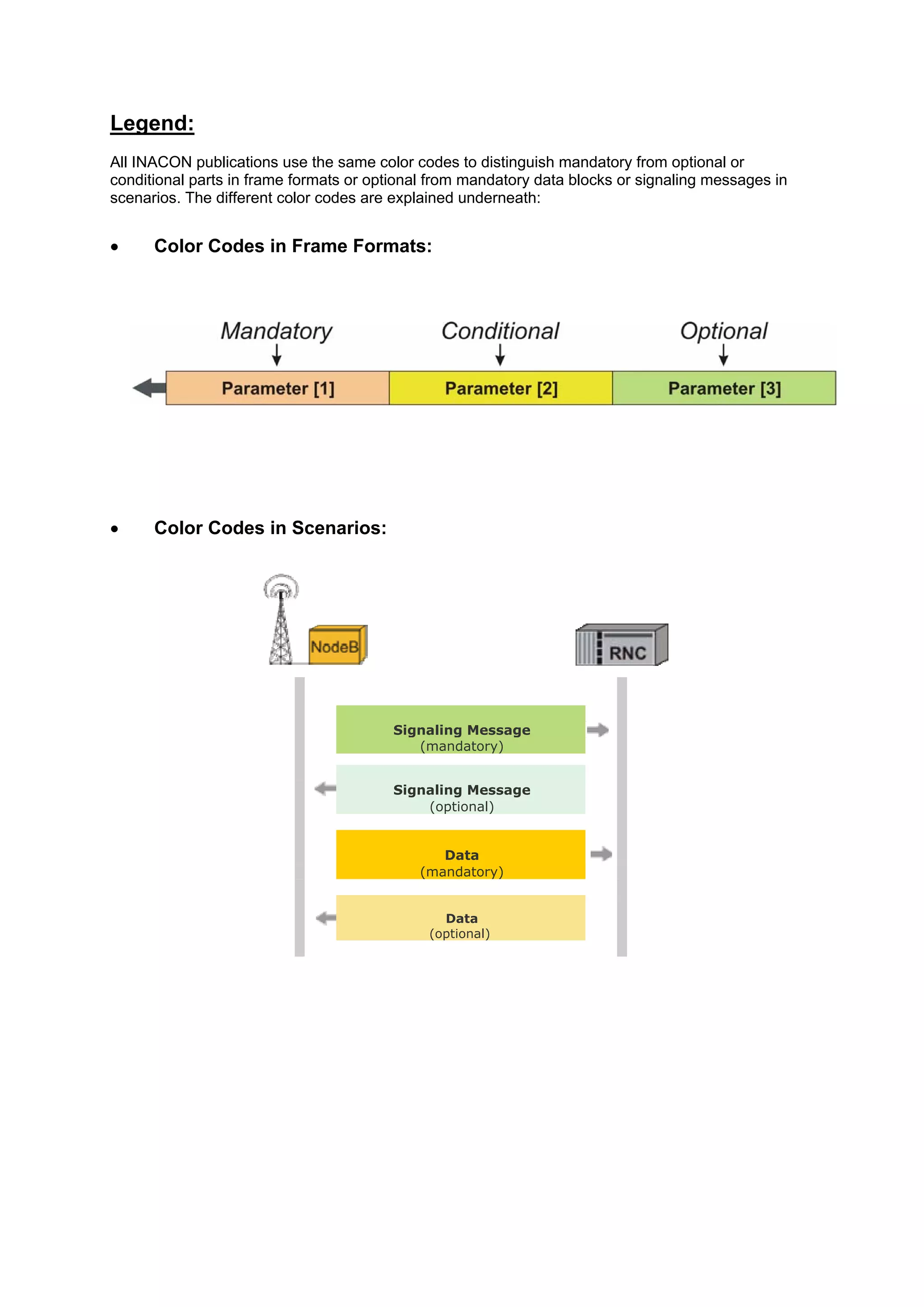
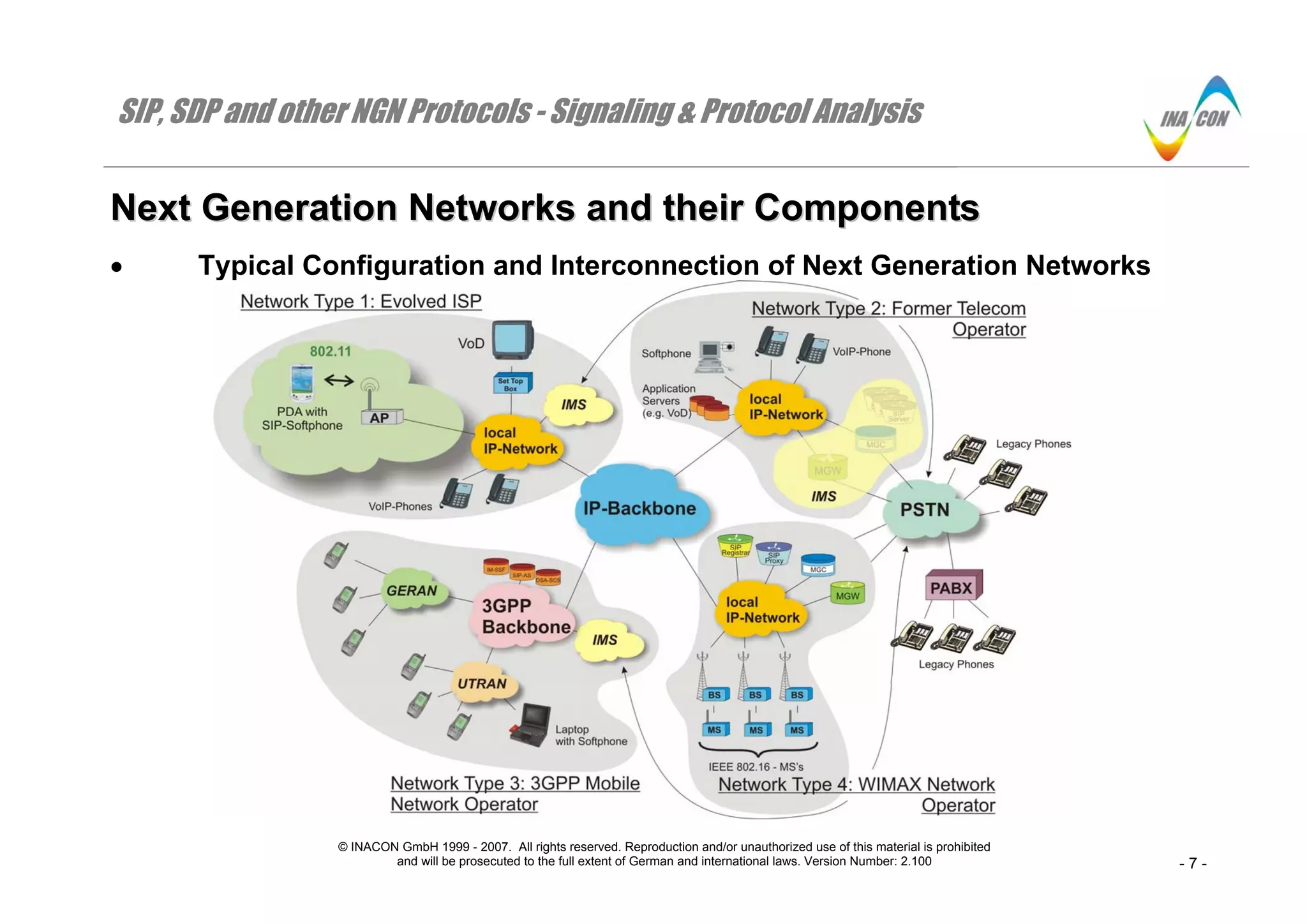
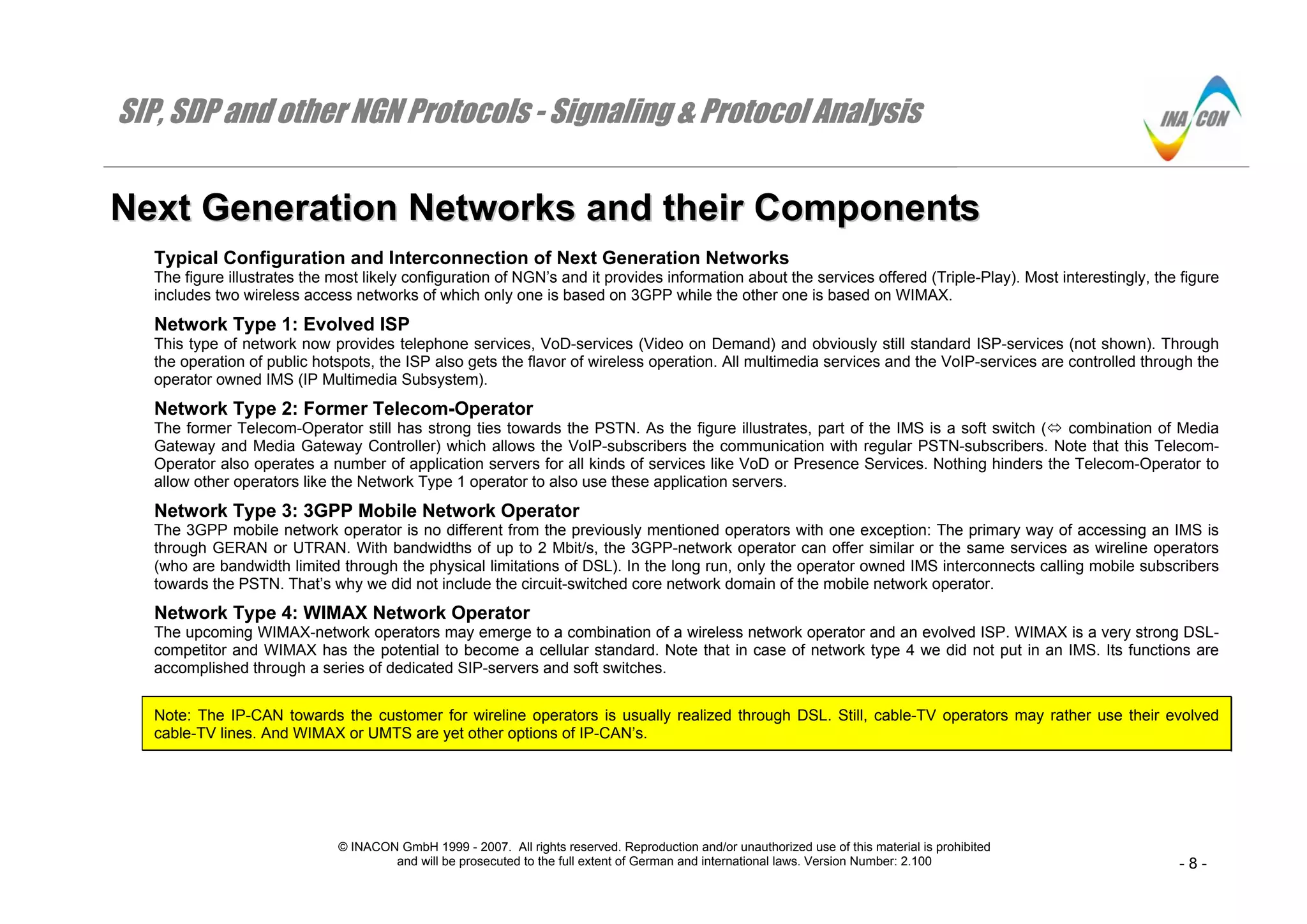
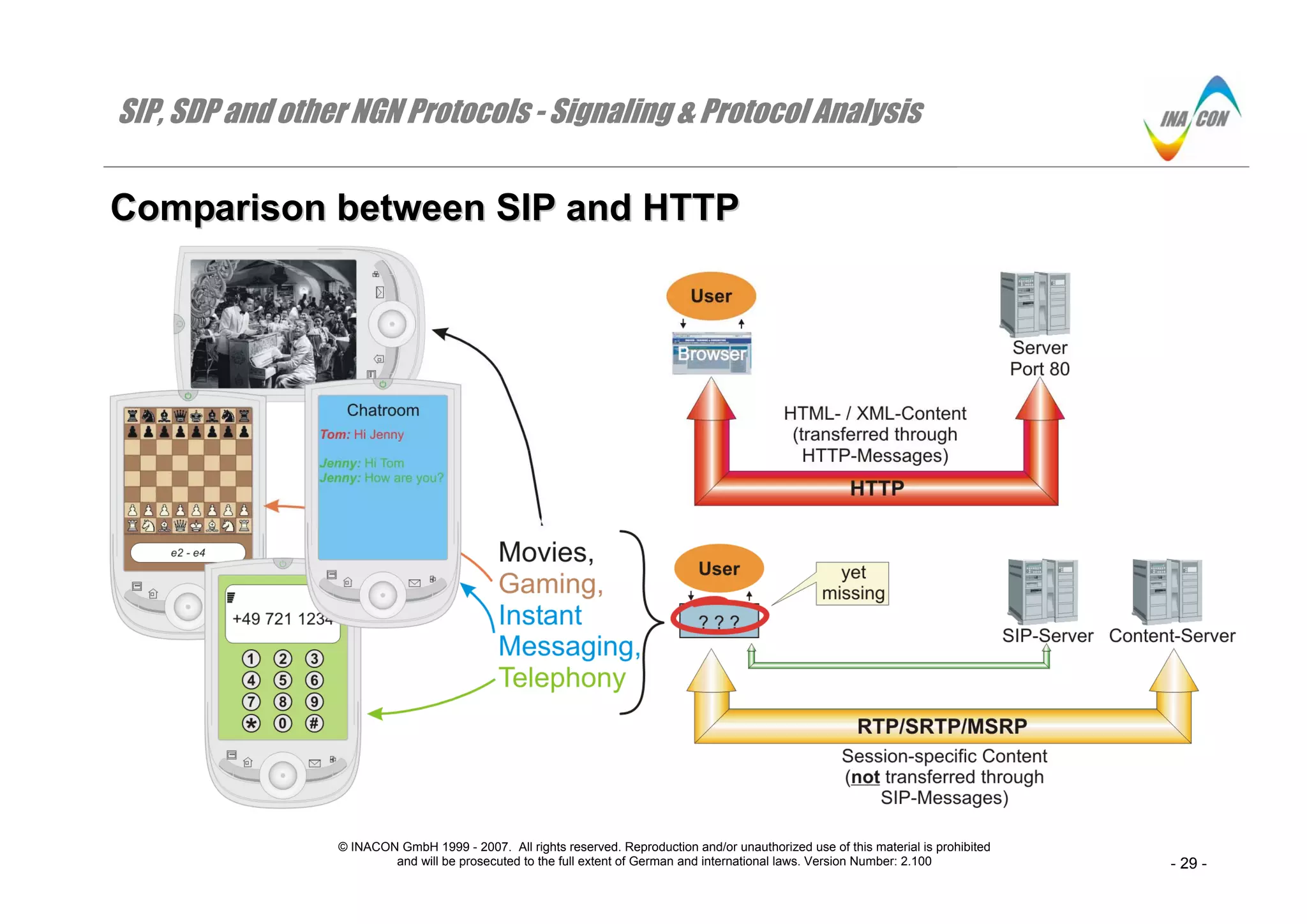
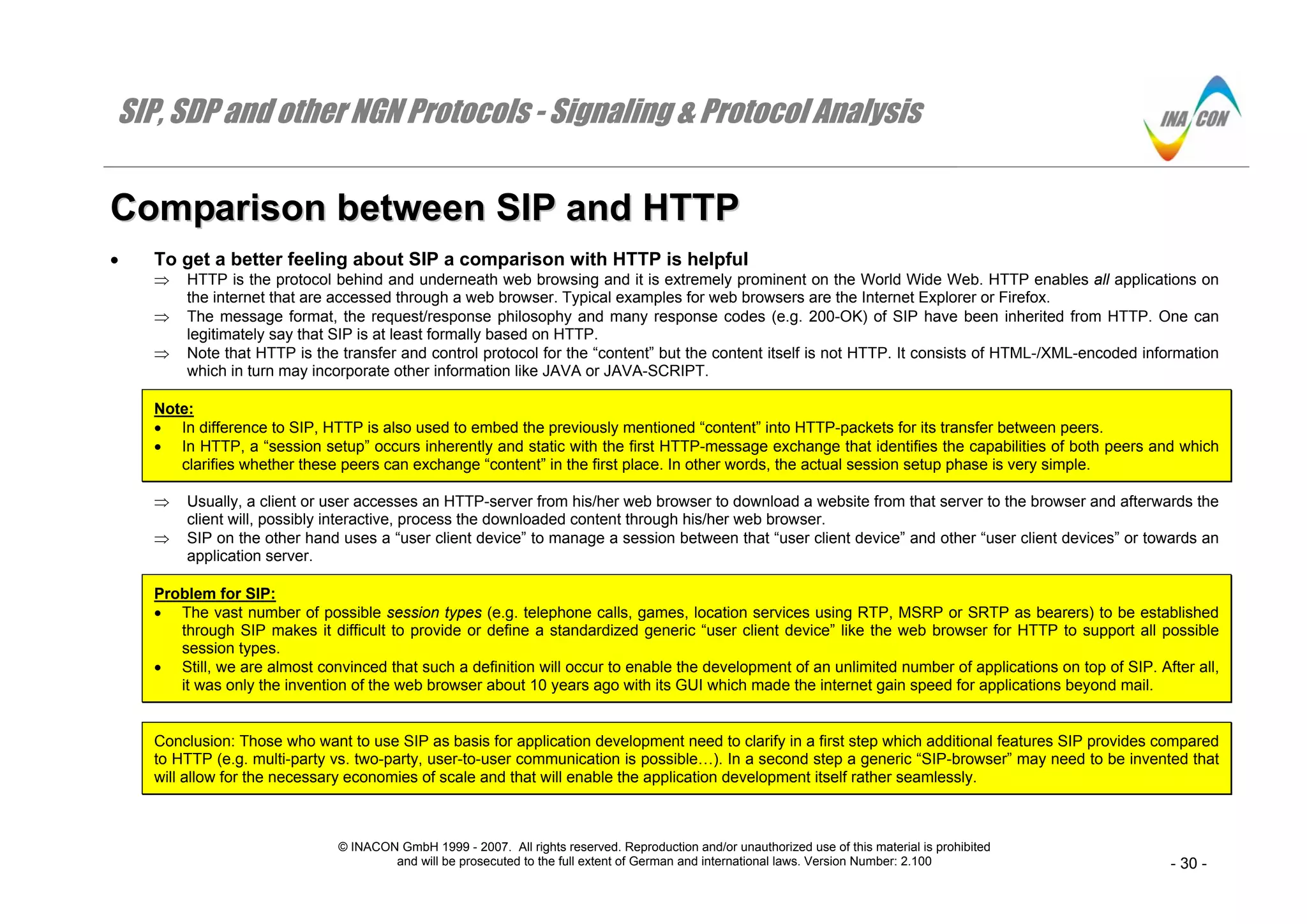
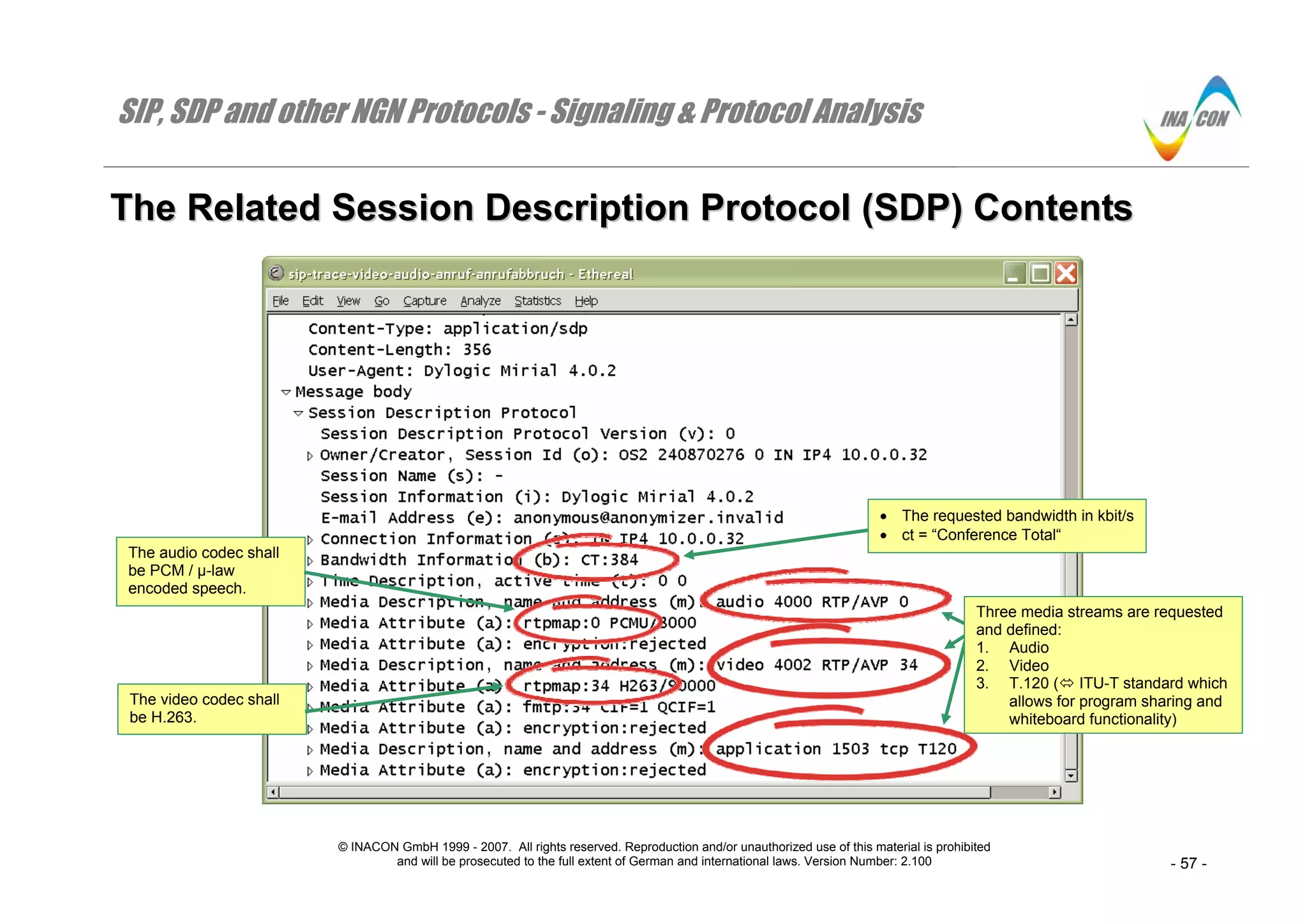
![SIP, SDP and other NGN Protocols - Signaling & Protocol Analysis
© INACON GmbH 1999 - 2007. All rights reserved. Reproduction and/or unauthorized use of this material is prohibited
and will be prosecuted to the full extent of German and international laws. Version Number: 2.100 - 58 -
TThhee RReellaatteedd SSeessssiioonn DDeessccrriippttiioonn PPrroottooccooll ((SSDDPP)) CCoonntteennttss
Additional Information
⇒ Detailed information about the meaning of the different SDP-parameters like “ct” or “RTP/AVP” is provided later in this book.
⇒ Unfortunately, the IETF never updates RFC’s but rather issues new RFC’s if new parameters as in case of SDP are added. Still, on the website
http://www.iana.org/assignments/sdp-parameters the IETF at least provides a summary of all SDP-parameters.
⇒ Similarly, for SIP the IETF maintains the website http://www.iana.org/assignments/sip-parameters where all SIP-parameters, header fields etc. can be
found.
⇒ Note the numbers ‘0’ and ‘34’ at the end of two media lines audio and video: These numbers represent the payload type values which will be used in
the header of the upcoming RTP-frames to identify the respective media and codec types.
⇒ Implicitly, the indicated receiver port numbers 4000 ( audio) and 4002 ( video) also determine to which port number any RTCP-messages shall be
sent (Real-time Transport Control Protocol). These shall be sent to the next higher port number, respectively [RFC 3264 (5.1)]. That is port number
4001 for the audio stream and 4003 for the video stream.
⇒ The numbers “8000” and “90000” behind the codec identifiers PCMU and H263 relate to the number of samples per second.
⇒ The terms “CIF = 1” and “QCIF = 1” in the fmtp-line for the H.263 video-codec ( 34) indicate support of that peer for QCIF (Quarter Common
Intermediate Format) and for CIF (Common Intermediate Format). QCIF and CIF relate to video resolutions in terms of number of lines and pixels per
line.](https://image.slidesharecdn.com/docfoc-160922051359/75/Docfoc-com-ngn-signaling-amp-amp-protocol-analysis-8-2048.jpg)
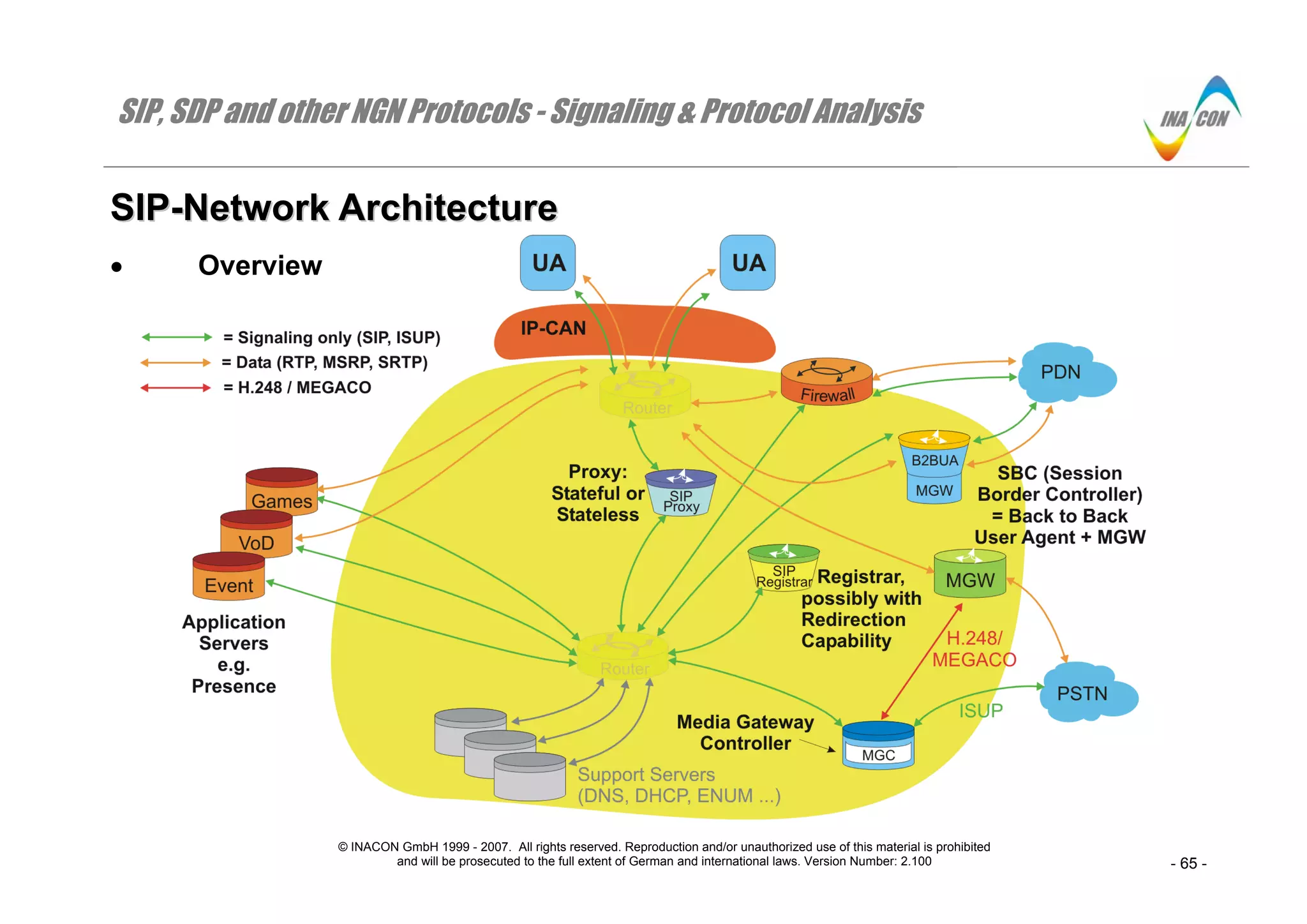
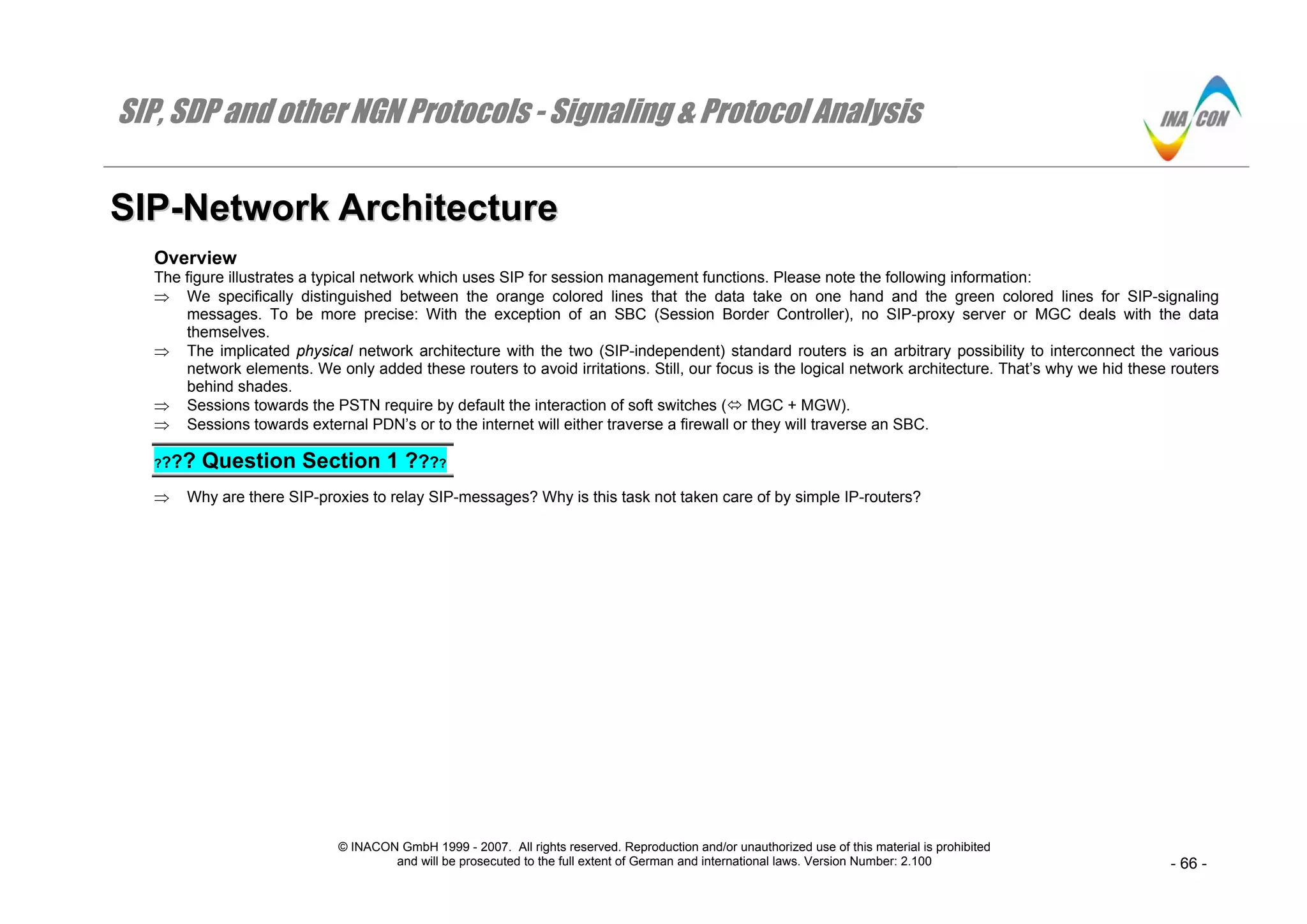
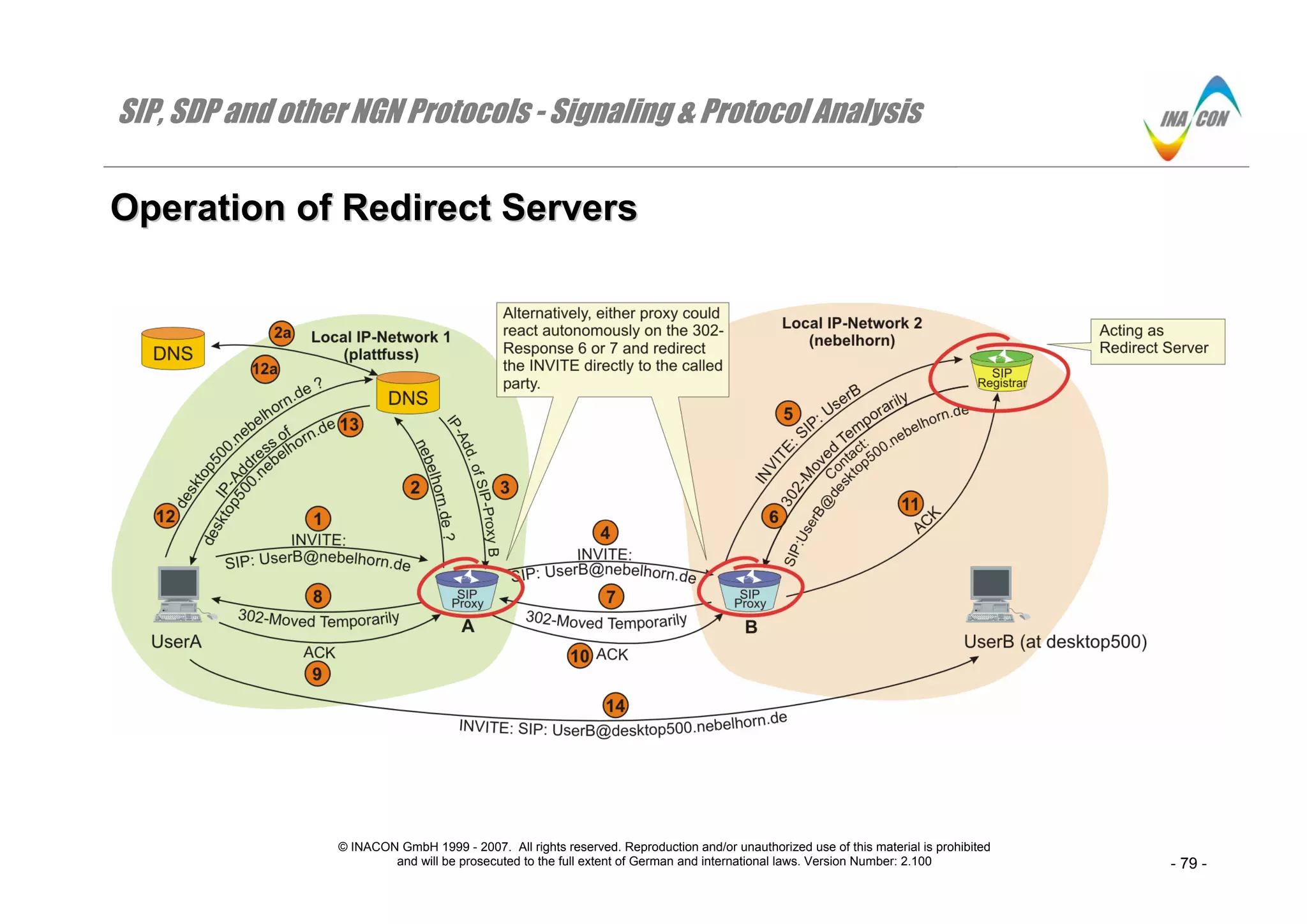
![SIP, SDP and other NGN Protocols - Signaling & Protocol Analysis
© INACON GmbH 1999 - 2007. All rights reserved. Reproduction and/or unauthorized use of this material is prohibited
and will be prosecuted to the full extent of German and international laws. Version Number: 2.100 - 80 -
OOppeerraattiioonn ooff RReeddiirreecctt SSeerrvveerrss
Introduction
A redirect server is a SIP-proxy server or a SIP-registrar that responds an incoming Request: INVITE with a Response: 3XX (e.g. 302-“Moved
Temporarily”). This response includes in the “Contact:”-header field the one or more current user device’s addresses that shall be contacted instead or
directly by the originating party.
Procedure Description
As illustrated in the figure, UserA sends an INVITE / sip: UserB@nebelhorn.de to its SIP-proxy server A ( message 1). The proxy server invokes the help
of one or more DNS-servers to resolve the IP-address of nebelhorn.de ( message 2, 2a and 3). Consequently, proxy A relays the INVITE-message to
SIP-proxy server B ( message 4).
⇒ Proxy B sends the INVITE-message to the responsible SIP-registrar ( message 5).
⇒ The SIP-registrar will issue a final Response: 302-“Moved Temporarily” which traverses all the way back to UserA ( message 6, 7, 8) and which
ultimately is the message that will trigger the redirection of the request.
Note the comment on the graphics slide: Either SIP-proxy server could react on the Response: 302-Moved Temporarily autonomously and redirect the
Request: INVITE to its new destination directly.
⇒ As mentioned before, this response message type always carries in its “Contact:”-header field the current IP-address or FQDN where the requested
part can be found. In our case, this is the fully qualified domain name desktop500.nebelhorn.de.
⇒ Before another INVITE to UserB at desktop500.nebelhorn.de can be sent, UserA needs to finish the previous INVITE-transaction by issuing a
Request: ACK and sending it to the registrar in local IP-network 2 ( message 9, 10, 11).
⇒ To be able to send an INVITE-message to sip: UserB@desktop500.nebelhorn.de, UserA invokes the support of one ore more DNS-servers to resolve
the FQDN into an IP-address ( messages 12, 12a and 13).
⇒ Finally, UserA can send a Request: INVITE / sip: UserB@desktop500.nebelhorn.de directly to UserB. No SIP-proxy server is used ( message 14).
Redirection is well suited to reduce the load of SIP-proxies but it is not well suited for carrier based services which require at least a SIP-proxy server for
charging purposes.
[RFC 3261 (8.3)]
???? Question Section 2 ????
⇒ If either SIP-proxy would autonomously redirect the INVITE to its new destination, would this be a stateful or a stateless proxy server or both?](https://image.slidesharecdn.com/docfoc-160922051359/75/Docfoc-com-ngn-signaling-amp-amp-protocol-analysis-12-2048.jpg)
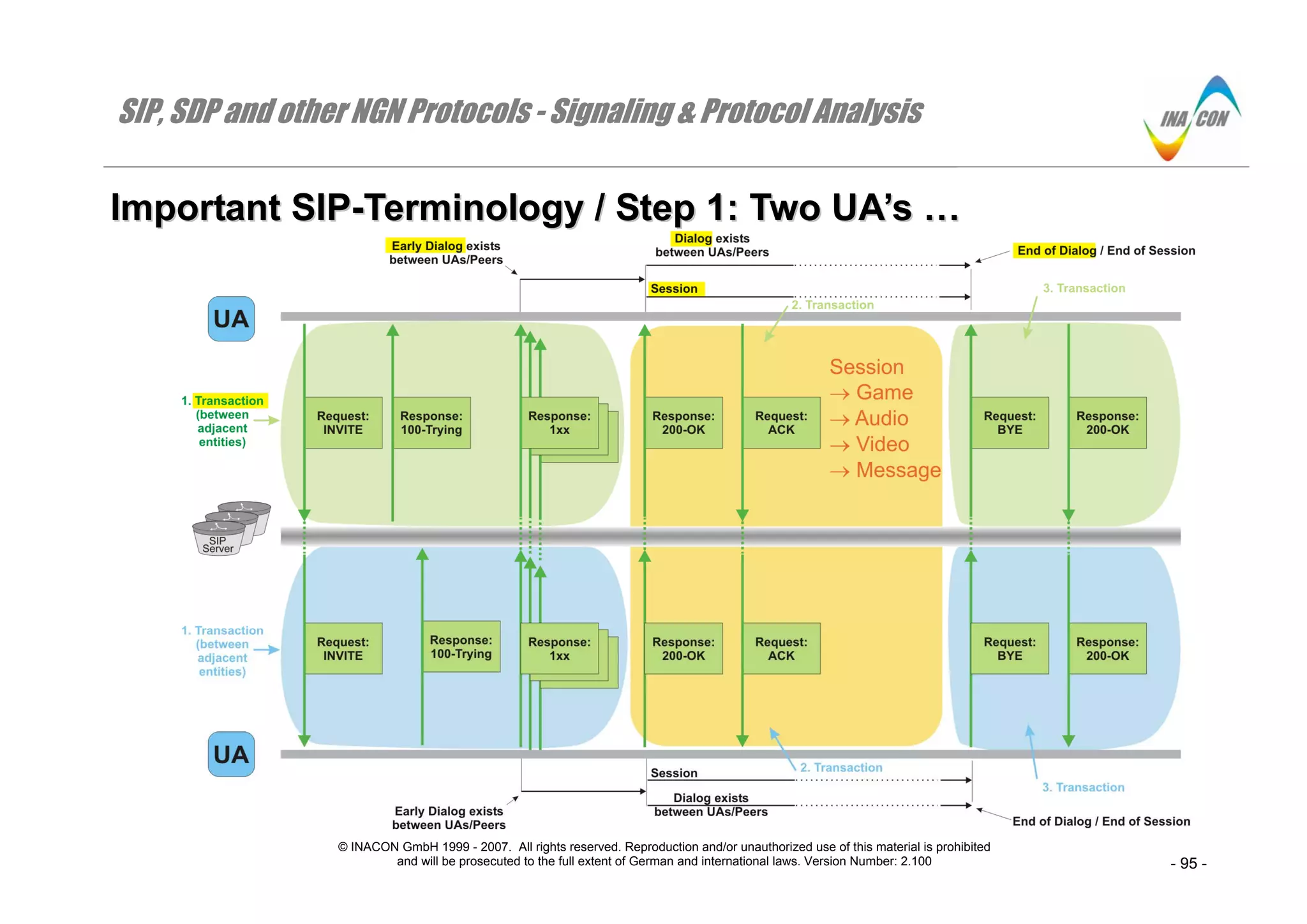
![SIP, SDP and other NGN Protocols - Signaling & Protocol Analysis
© INACON GmbH 1999 - 2007. All rights reserved. Reproduction and/or unauthorized use of this material is prohibited
and will be prosecuted to the full extent of German and international laws. Version Number: 2.100 - 96 -
IImmppoorrttaanntt SSIIPP--TTeerrmmiinnoollooggyy // SStteepp 11:: TTwwoo UUAA’’ss ……
We start with the limitation of only two users (no SIP-forking) to simplify things initially. In a second step we shall handle the case of multiple users).
Transaction)
Each SIP-transaction consists of a single request message which is sent by a UAC (User Agent Client) and the related final response message which is
sent by the adjacent UAS (User Agent Server). If the request message is an INVITE, then there are zero or more provisional responses between the
INVITE and the final response message. Note that the term “adjacent” in the previous sentence means that transactions ultimately exist between adjacent
SIP-entities (e.g. UA and proxy) and not necessarily between peers (the two UA’s in the graphics) [RFC 3261 (p.24)].
The exception to this rule is indicated in the figure: The successful dialog establishment through the initial INVITE-transaction shall be acknowledged by a
Request: ACK-message which is considered to be a second transaction but which is not responded at all (although it is a SIP-Request). The Request: ACK
really is a new transaction, considering the fact that a new branch-value is used. However, as we will see later, the transaction number ( CSeq) does not
get incremented from the Request: INVITE that the Request: ACK relates to [RFC 3261 (p.24)].
Dialog / Call / Early Dialog (Definition)
⇒ Dialog establishment is initiated when a UAC sends a Request: INVITE-message towards another peer, with this message possibly traversing one or
more SIP-proxies.
⇒ Dialog establishment can only be triggered by Request: INVITE and (new with RFC 3515) also by Request: REFER.
⇒ Dialogs only exist between two UA’s / peers. There can be no dialogs between a UA and a SIP-proxy.
⇒ A dialog has been established as soon as a UAS responds to a Request: INVITE with a non-failure final response message ( 200-OK). This rule
means that the reception of a 2XX-response by a UAC establishes a dialog between these two users. This also is the start of the session.
⇒ An early dialog is there, if a UAS responds to a Request: INVITE with a provisional Response: “101 – 199” message ( which excludes “100”
(Trying)) [RFC 3261 (12.1)]. The benefit of the definition of an “early dialog” is that the UAC may send further SIP-Requests (e.g. UPDATE) to the
UAS already while the dialog is in its early state [RFC 3261 (13.2.2.1)].
⇒ In SIP, a call consists of one or more dialogs [RFC 3261 (p.78)]. More than one dialog per call is only possible for multiparty calls.
⇒ Dialogs are terminated by either party by sending a Request: BYE-message. Early dialogs can be terminated by the UAC by sending a Request:
CANCEL-message
Each dialog is identified by the Call-ID-value which is initially allocated by the peer that sent the Request: INVITE-message and by the “To:”- and “From:”-
tag values. We will get back to these identifiers in a few slides.](https://image.slidesharecdn.com/docfoc-160922051359/75/Docfoc-com-ngn-signaling-amp-amp-protocol-analysis-14-2048.jpg)
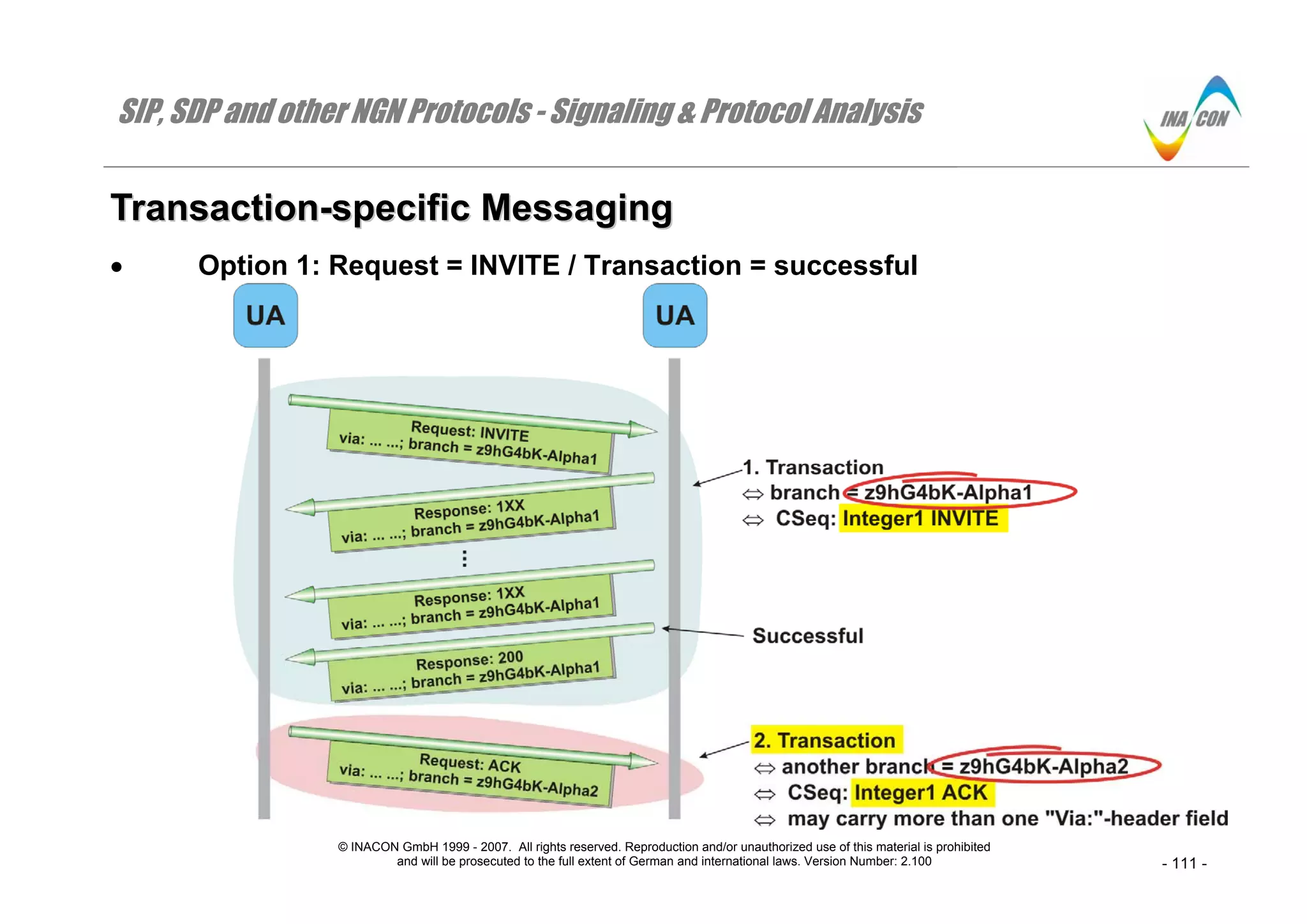
![SIP, SDP and other NGN Protocols - Signaling & Protocol Analysis
© INACON GmbH 1999 - 2007. All rights reserved. Reproduction and/or unauthorized use of this material is prohibited
and will be prosecuted to the full extent of German and international laws. Version Number: 2.100 - 112 -
TTrraannssaaccttiioonn--ssppeecciiffiicc MMeessssaaggiinngg
Option 1: Request = INVITE / Transaction = successful
⇒ If a transaction is initiated by a Request: INVITE-message, then the final Response: 200 shall be acknowledged by the UAC through a Request: ACK-
message.
⇒ Since this Request: ACK-message is considered as a new transaction, it shall be equipped with a new branch-parameter value ( “z9hG4bK-
Alpha2”). Note that each proxy between the two UA’s will add its own “Via:”-header field to the traversing Request: ACK-message which is different to
an unsuccessful INVITE-transaction.
⇒ Despite this fact, the Request: ACK-message shall use the same “CSeq:”-value as the original Request: INVITE-message. However, the “CSeq:”-
method shall be ACK [RFC 3261 (p.82)].
[RFC 3261 (17.1.1), (17.2.1)]
???? Question Section 6 ????
⇒ Why does SIP deploy a “3-Way Handshake” –procedure (1. INVITE / 2. 200-OK / 3. ACK) in the first place?
⇒ Why is ACK considered as a new transaction?](https://image.slidesharecdn.com/docfoc-160922051359/75/Docfoc-com-ngn-signaling-amp-amp-protocol-analysis-16-2048.jpg)
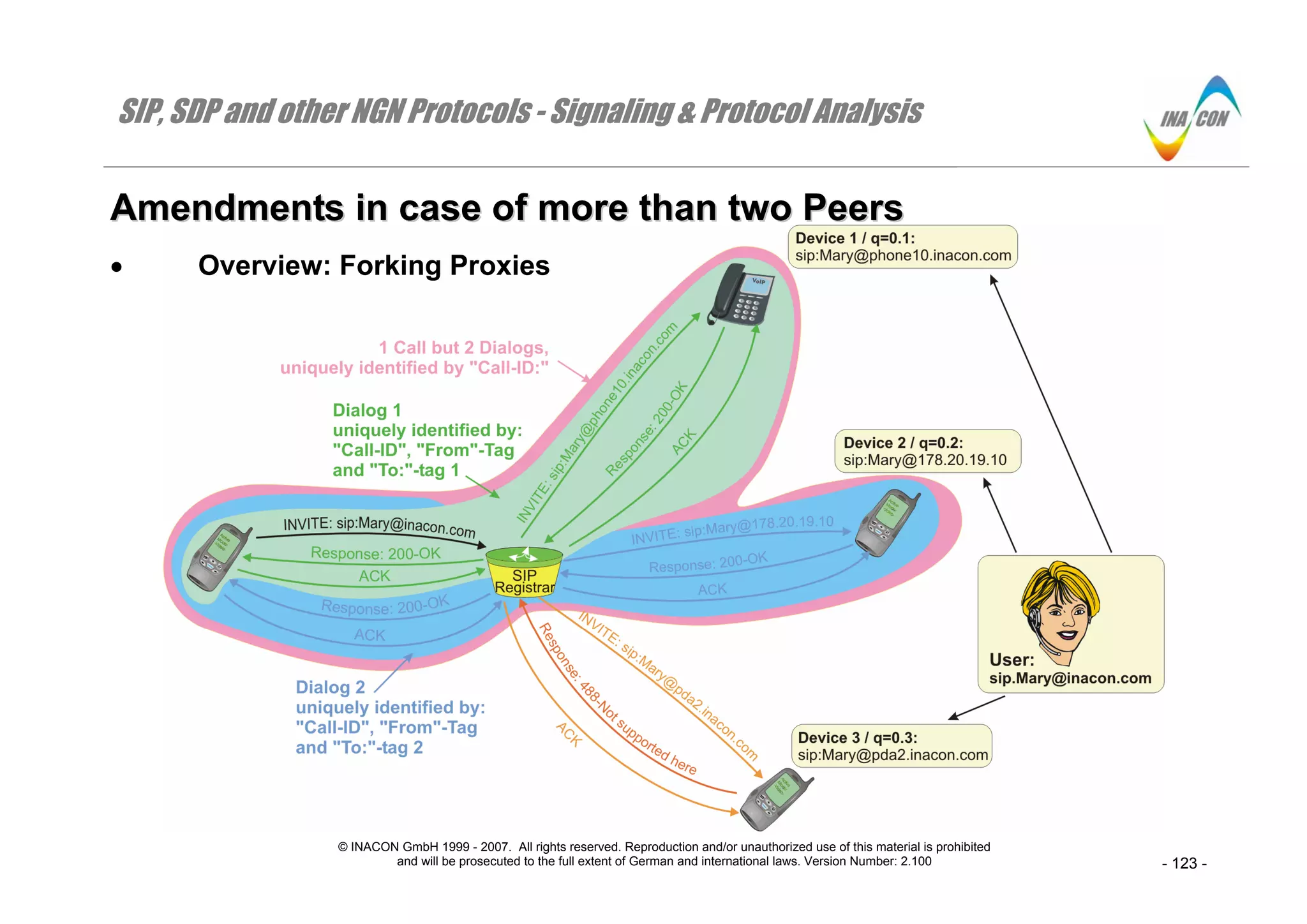
![SIP, SDP and other NGN Protocols - Signaling & Protocol Analysis
© INACON GmbH 1999 - 2007. All rights reserved. Reproduction and/or unauthorized use of this material is prohibited
and will be prosecuted to the full extent of German and international laws. Version Number: 2.100 - 124 -
AAmmeennddmmeennttss iinn ccaassee ooff mmoorree tthhaann ttwwoo PPeeeerrss
Introducing Different Contact Addresses per User
⇒ A user may have registered different contact addresses to his/her registrar. In our example, the user sip: Mary@inacon.com registered to her registrar
from different SIP-devices of which each one conveyed a different SIP-URI in the “Contact:”-header field to the registrar (not shown). These
“Contact:”-header SIP-URI’s are the ones that we indicate as device SIP-addresses. Note that each of these “Contact:”-header SIP-URI’s relates to a
specific IP-address
⇒ As illustrated, there is also a ‘q’-parameter (q = qualifier = 0.000 – 1.000) used during the registration to provide for a different prioritization of the
different “Contact:”-addresses. The smaller ‘q’, the higher the priority. The forking registrar does not care in this case and relays the Request: INVITE
to all destinations simultaneously. Alternatively, a predefined q=1.0 could be used as identifier for the voicemail URI of a user.
Behavior of Forking Proxies
⇒ Forking proxies either receive their location information from registrars or they are registrars themselves (the case which is illustrated in our example).
⇒ Such a forking proxy will relay a received Request: INVITE-message not only to a single destination but to several different ones.
The Terms Call, Dialog, Session and Transaction in case of Forking
The figure emphasizes what we already introduced earlier:
⇒ A dialog between two peers is established as soon as the Response: 200-OK is received from the called peer. Each dialog is uniquely identified by the
“Call-ID:” and the “To:”- and “From:”-header field tags.
⇒ In case of multiparty ( in our example let Mary herself answer at device 1 but somebody else answers at device 2) a call consists of all the different
dialogs. Obviously, a call equals a dialog if only two parties are involved.
⇒ Although the detailed message parameters will be illustrated on the following slides we like to say that between the calling party and the registrar, all
messages except the Request: ACK’s for the Responses: 200-OK represent only a single transaction despite the fact that the two Response: 200-OK
messages belong to two different dialogs!
⇒ Obviously, the registrar establishes a separate transaction to each of the called parties. And obviously, the relayed Request: ACK-messages towards
device 1 and 2 are again separate transactions.
⇒ A very important new behavior of SIP-proxies in general is illustrated between the registrar and device 3. For one or another reason, device 3 rejects
the incoming Request: INVITE with a final Response: 488-“Not Supported Here”.
Note:
• In the example, the SIP-proxy / registrar does not relay this unsuccessful response to the calling party but rather handles the respective
acknowledgement independently and by itself. Likewise, such a SIP-proxy / registrar could issue a Request: CANCEL-message.
[RFC 3261 (p.78)]](https://image.slidesharecdn.com/docfoc-160922051359/75/Docfoc-com-ngn-signaling-amp-amp-protocol-analysis-18-2048.jpg)
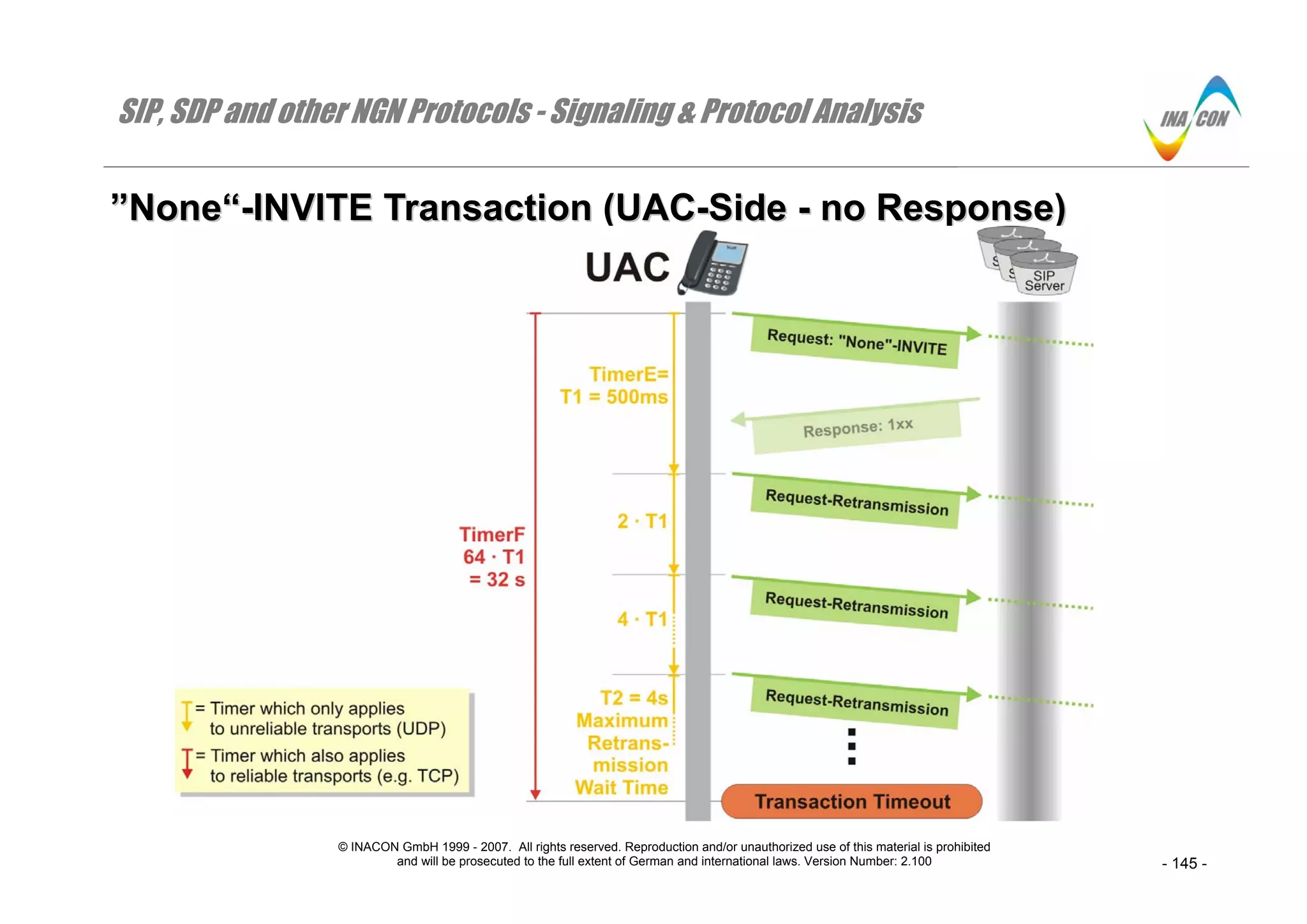
![SIP, SDP and other NGN Protocols - Signaling & Protocol Analysis
© INACON GmbH 1999 - 2007. All rights reserved. Reproduction and/or unauthorized use of this material is prohibited
and will be prosecuted to the full extent of German and international laws. Version Number: 2.100 - 146 -
””NNoonnee““--IINNVVIITTEE TTrraannssaaccttiioonn ((UUAACC--SSiiddee -- nnoo RReessppoonnssee))
Overview
When the UAC issues a “None”-INVITE-Request, it will start timer F and possibly timer E within its transaction management sublayer. This relates to all
SIP-requests, except Request: ACK ( CANCEL, MESSAGE, OPTIONS, INFO…).
Timer E
⇒ Timer E is there to control retransmissions of the Request: “None”-INVITE-message in case of unreliable transport protocols ( UDP).
⇒ Timer F is the transaction surveillance timer.
⇒ As illustrated in the figure, the UAC will retransmit the Request: “None“-INVITE-message upon every expiry of timer E. The duration of timer E doubles
with each expiry ( exponential back off) until a maximum retransmit interval of 4 s is reached.
⇒ Note that the reception of provisional response messages for that Request has no impact on timer E.
Expiry of Timer F
⇒ Upon expiry of timer F, the UAC considers a transaction timeout and deletes the transaction.
[RFC 3261 (17.1.2), Annex A]
Timer 1, Timer 2, Timer E and Timer F in case of 3GPP-Networks
Timer Value to be used between P-CSCF and UE Value to be used between SIP-nodes within the IMS
Timer 1 (T1) 2 s 0.5 s
Timer 2 (T2) 16 s 4 s
Timer E Initially T1 Initially T1
Timer F 128 s 32 s
[3GTS 24.229 (7.7)]](https://image.slidesharecdn.com/docfoc-160922051359/75/Docfoc-com-ngn-signaling-amp-amp-protocol-analysis-20-2048.jpg)
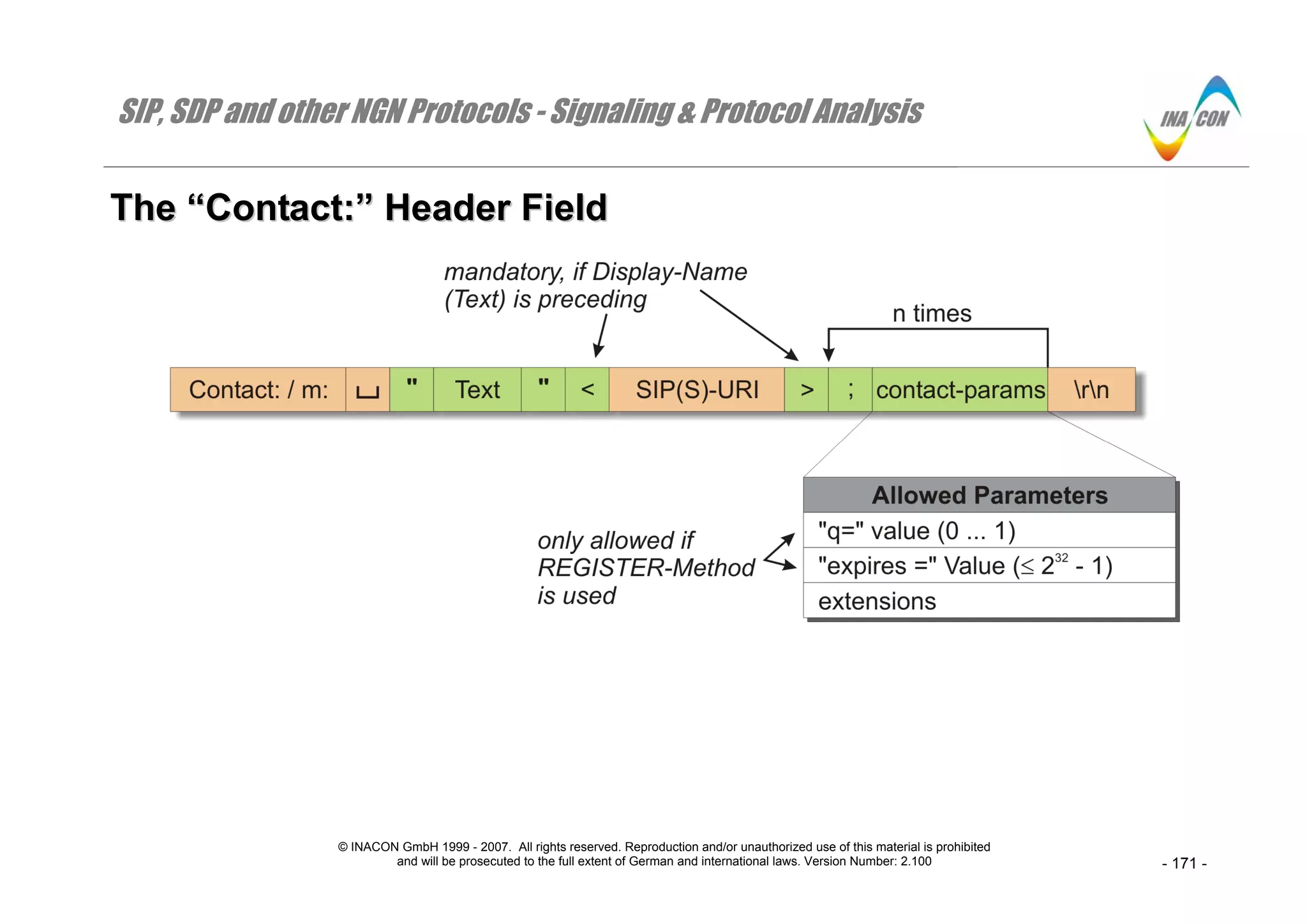
![SIP, SDP and other NGN Protocols - Signaling & Protocol Analysis
© INACON GmbH 1999 - 2007. All rights reserved. Reproduction and/or unauthorized use of this material is prohibited
and will be prosecuted to the full extent of German and international laws. Version Number: 2.100 - 172 -
TThhee ““CCoonnttaacctt::”” HHeeaaddeerr FFiieelldd
The “Contact:”-header field most importantly identifies the originator of that request to be used as identifier in subsequent requests. The “Contact:”-header
field value may contain a display-name, a URI with URI parameters (see SIP(S)-URI) and additional header parameters. Only the provision of the SIP(S)-
URI is mandatory. The enclosing “<” and “>” are mandatory, if a display-name is preceding.
As the figure illustrates, “Contact:”-specific parameters shall be delimited from each other through a “;”-character. Context-specific parameters may be
defined but the two indicated parameters “q” and “expires” must only be present in REGISTER-request messages.
The parameter “q” allows to relatively prioritizing subsequent REGISTER-requests from different locations to be contacted in case of a terminating
transaction.
The parameter “expires” contains the registration timeout (the period after which re-registration is required) as desired by the user in REGISTER-request
messages or the possibly downgraded timeout in the respective response message from the registrar. Note that the “contact-params” are provided per
“Contact:”-parameter which means that different expiration times can be indicated per “Contact:”-address.
As an alternative, the dedicated “Expires:”-header field can be used which then applies globally [RFC 3261 (10.2.1.1)].
[RFC 3261 (8.1.1.8), (20.10)]
Note that in 3GPP-networks, the UA shall re-register 600 seconds before the “expires”-timer expires (if the timer value is larger than 1200 s) or after half of
the time indicated by the “expires”-timer has elapsed (if the timer value is 1200 s or smaller) [3GTS 24.229 (5.1.1.4)]](https://image.slidesharecdn.com/docfoc-160922051359/75/Docfoc-com-ngn-signaling-amp-amp-protocol-analysis-22-2048.jpg)
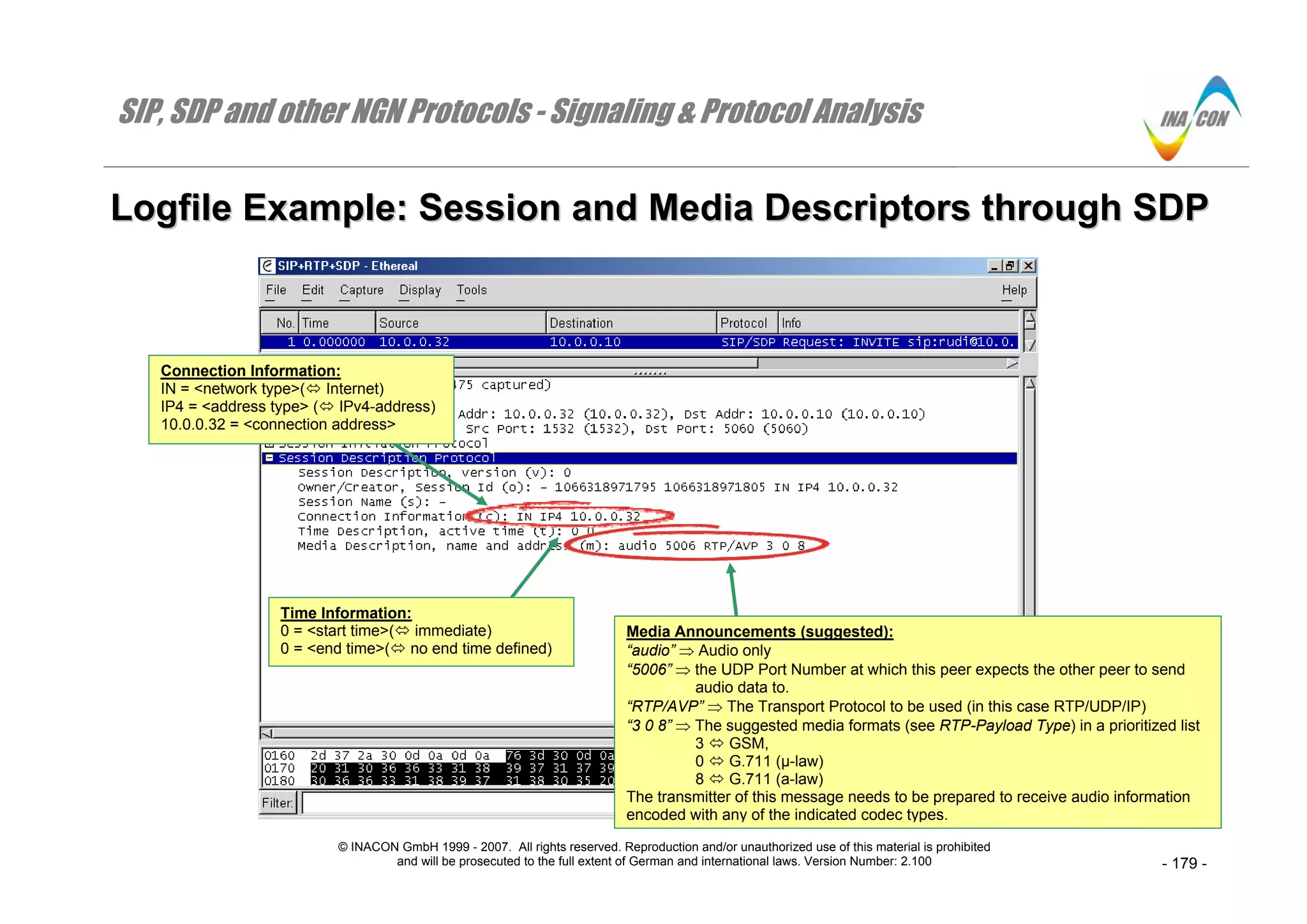
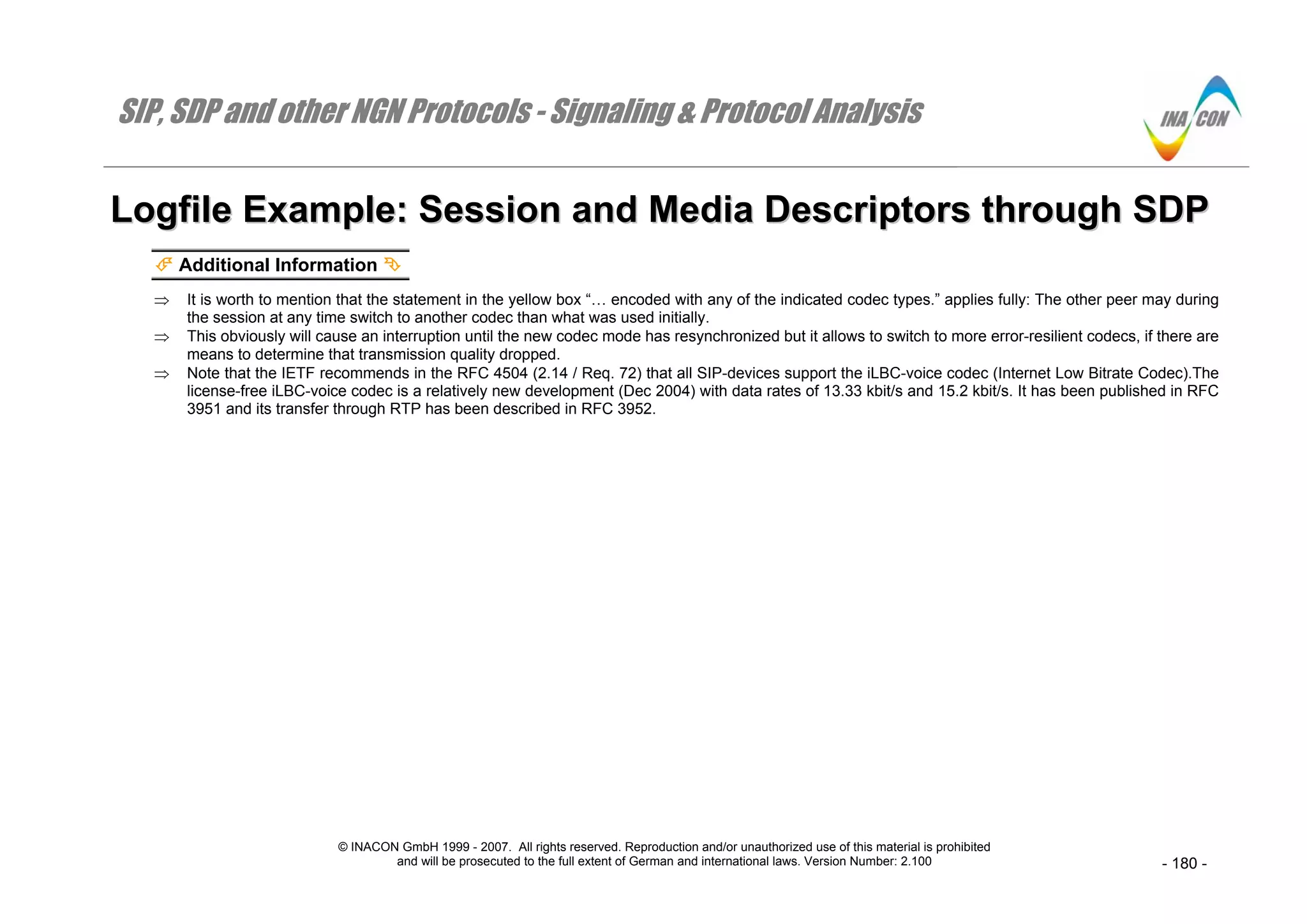
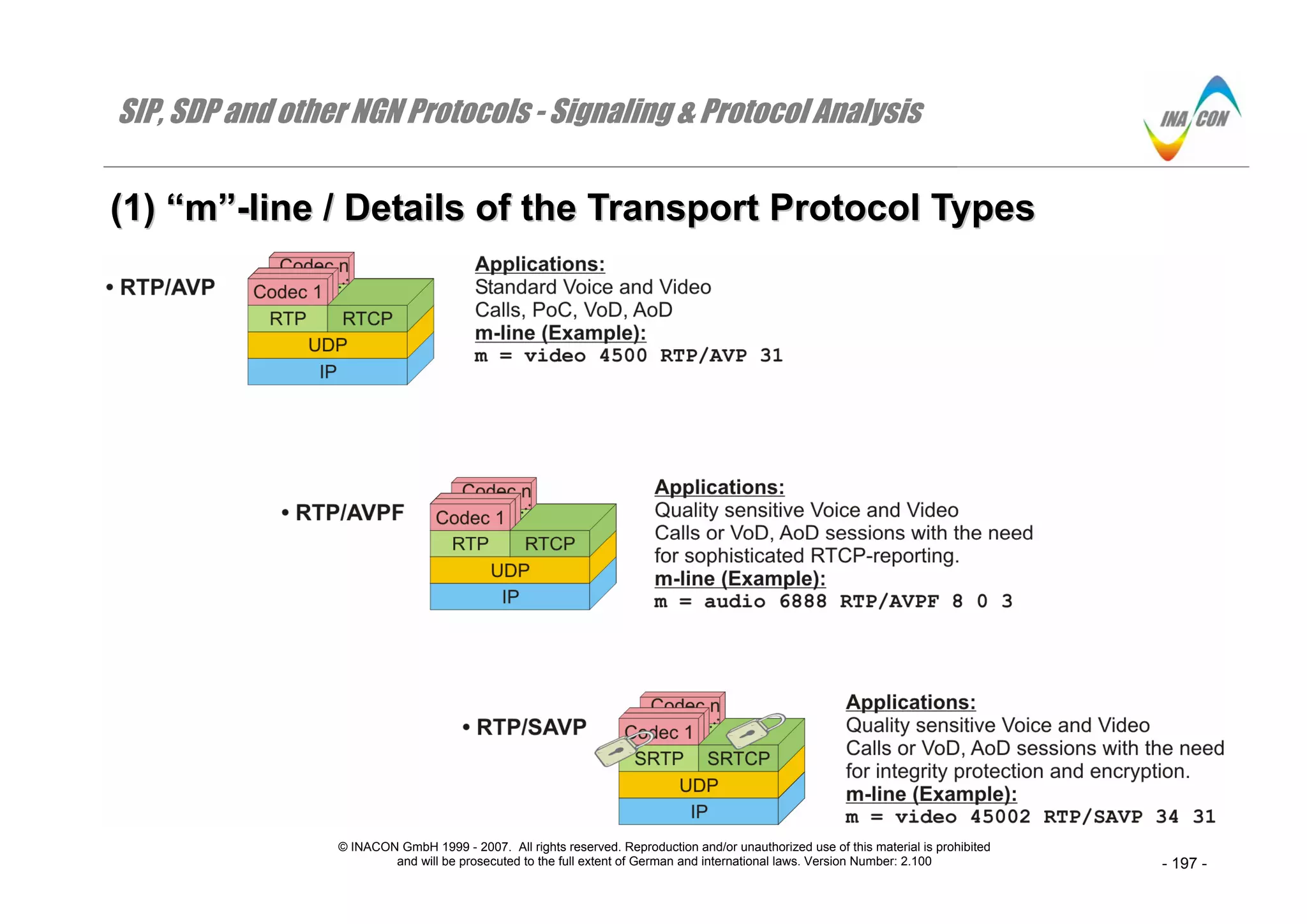
![SIP, SDP and other NGN Protocols - Signaling & Protocol Analysis
© INACON GmbH 1999 - 2007. All rights reserved. Reproduction and/or unauthorized use of this material is prohibited
and will be prosecuted to the full extent of German and international laws. Version Number: 2.100 - 198 -
((11)) ““mm””--lliinnee // DDeettaaiillss ooff tthhee TTrraannssppoorrtt PPrroottooccooll TTyyppeess
RTP/AVP
The related protocol stack is most frequently used as it is well suited for real-time user applications like voice calls or video conferencing. Note that the
protocol stack always contains two parts: one for RTP and the voice or video codec on top and another one for RTCP.
RTP/AVP is also applicable in case of unidirectional VoD or AoD-sessions in which case a media stream only flows in one direction. The structure of the m-
line is also indicated. The payload-type-list does contain one or more integer codec identifiers which are used within the payload type field of the related
RTP-frames
[RFC 3551]
RTP/AVPF
The same applies which has been said about RTP/AVP. The only difference between RTP/AVP and RTP/AVPF is the use of advanced “Feedback” reports
on RTCP-level. These advanced feedback reports provide information about lost RTP-frames and their numbers or encoder specific feedback information
about lost graphics frames (which is important for high quality video conferencing and VoD).
[draft-ietf-avt-rtcp-feedback-11.txt]
RTP/SAVP
The related protocol stack indicates the additional value of RTP/SAVP over RTP/AVP: It uses SRTP and SRTCP to provide privacy in the user plane. In
that respect, privacy relates to RTP- / RTCP-data frame integrity protection, replay protection and encryption. The provision of the related keying material is
out of the scope of RTP/SAVP and SRTP.
[RFC 3711]](https://image.slidesharecdn.com/docfoc-160922051359/75/Docfoc-com-ngn-signaling-amp-amp-protocol-analysis-26-2048.jpg)

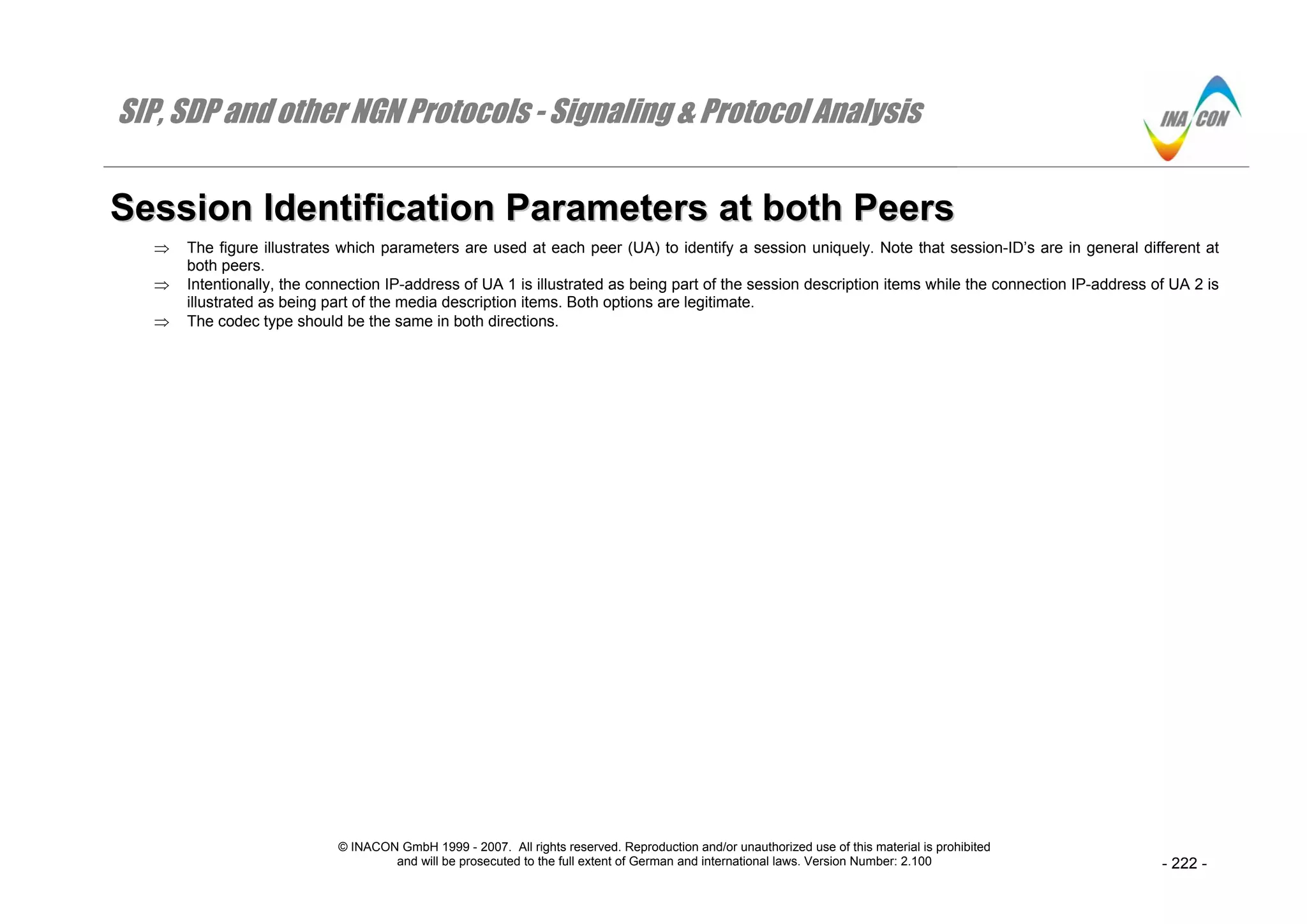

![SIP, SDP and other NGN Protocols - Signaling & Protocol Analysis
© INACON GmbH 1999 - 2007. All rights reserved. Reproduction and/or unauthorized use of this material is prohibited
and will be prosecuted to the full extent of German and international laws. Version Number: 2.100 - 236 -
DDNNSS--QQuueerriieess wwiitthh NNAAPPTTRR-- aanndd SSRRVV--RReeccoorrddss
⇒ The regular DNS-queries to resolve an FQDN into an IP-address can be expanded through service specific aspects.
⇒ That is the domain of the so called NAPTR- and SRV-records (Naming Authority Pointer / Service Location) that allow for the resolution of an FQDN
and a service (e.g. SIP) into one or more IP-addresses within that domain that can be contacted.
NAPTR-Records
⇒ Usually, a query starts with the request for the NAPTR-records of a domain for a given service. Consider for instance that a DNS-query is received by
a DNS server for sip:Miriam@inacon.com. The client performs a NAPTR query for that domain, and the DNS-server responds with the following
NAPTR-records:
“SIP+D2T” _sip.tcp.inacon.com
“SIP+D2U” _sip.udp.inacon.com
SRV-Records
⇒ In a second step, the requesting client will decide to use UDP to contact the incoming SIP-server for inacon.com and will send a second DNS-query
which resolves the SRV-record _sip.udp.inacon.com into an FQDN or directly into an IP-address which is then used as destination IP-address for the
SIP-message to be sent to sip: Miriam@inacon.com
[RFC 2782 (SRV), RFC 2915 (NAPTR), RFC 3263]](https://image.slidesharecdn.com/docfoc-160922051359/75/Docfoc-com-ngn-signaling-amp-amp-protocol-analysis-30-2048.jpg)
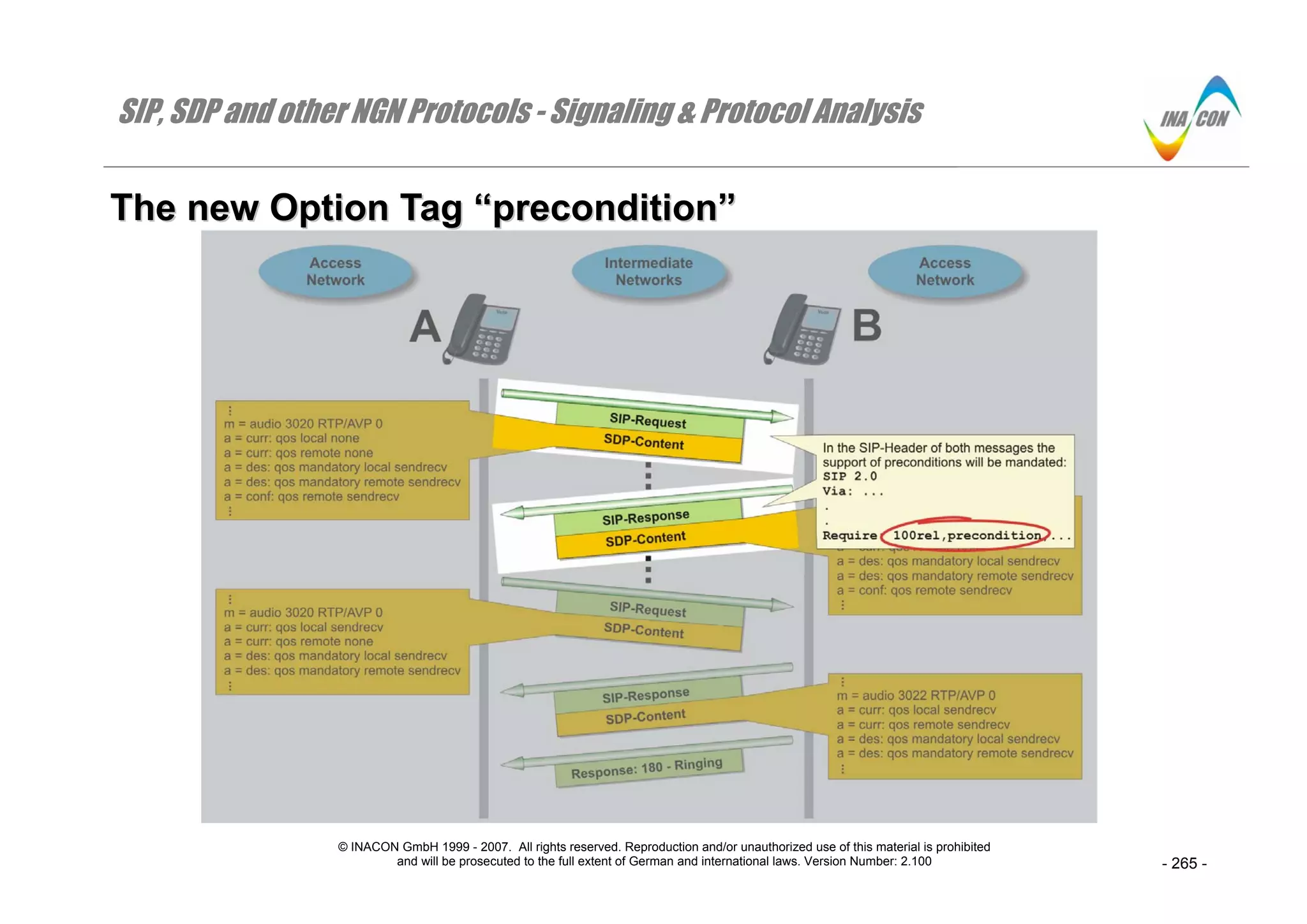
![SIP, SDP and other NGN Protocols - Signaling & Protocol Analysis
© INACON GmbH 1999 - 2007. All rights reserved. Reproduction and/or unauthorized use of this material is prohibited
and will be prosecuted to the full extent of German and international laws. Version Number: 2.100 - 266 -
TThhee nneeww OOppttiioonn TTaagg ““pprreeccoonnddiittiioonn””
⇒ The figure illustrates it: Preconditions within SDP-bodies cannot just be applied or used. The Request: INVITE and the related Response-messages
will mandate the use of preconditions by including the option tag “precondition” in the “Require:”-header field [RFC 3312 (11)].
⇒ This header field shall be used, if preconditions are mandatory. Alternatively, the option tag “precondition” may be added to the “Supported:”-header
field, if the preconditions are not mandatory.
Note that the support of “preconditions” also requires the support of “100rel” (acknowledged reliable provisional responses as per RFC 3262). Accordingly,
this option tag shall also be present [RFC 3312 (11)].](https://image.slidesharecdn.com/docfoc-160922051359/75/Docfoc-com-ngn-signaling-amp-amp-protocol-analysis-32-2048.jpg)

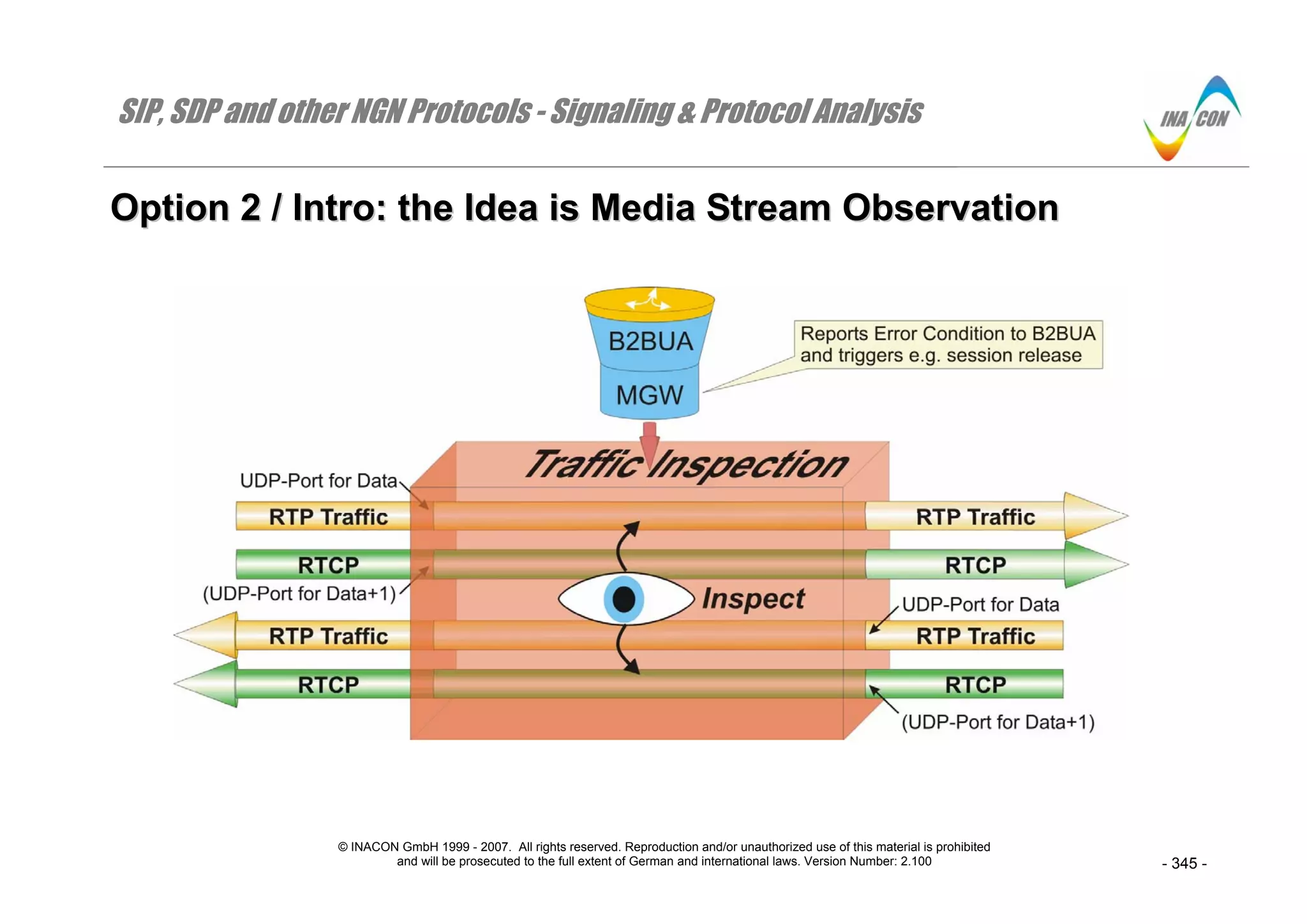
![SIP, SDP and other NGN Protocols - Signaling & Protocol Analysis
© INACON GmbH 1999 - 2007. All rights reserved. Reproduction and/or unauthorized use of this material is prohibited
and will be prosecuted to the full extent of German and international laws. Version Number: 2.100 - 346 -
OOppttiioonn 22 // IInnttrroo:: tthhee IIddeeaa iiss MMeeddiiaa SSttrreeaamm OObbsseerrvvaattiioonn
• The SBC (combination of B2BUA and MGW) is best suited for this task
• Media Stream Observation may relate to both: Inspection of the actual media stream and the associated RTCP-Reports
RTCP has become more sophisticated and more powerful through the introduction of extended RTCP-reports (RTCP XR RFC 3611) and through more
sophisticated reporting options according to the internet draft draft-ietf-avt-rtcp-feedback-XX.txt.
• If the Media Stream Observation reports back a fatal error of the media stream then it is the decision of the associated
SIP-proxy server to terminate the session towards both peers
Note that there are currently no rules as what needs to be considered a fatal error. It may for instance be that the MGW does not receive data packets for
some O&M-configurable time.
[RFC 3611, RFC 4083 (14.1), draft-ietf-avt-rtcp-feedback-XX.txt]](https://image.slidesharecdn.com/docfoc-160922051359/75/Docfoc-com-ngn-signaling-amp-amp-protocol-analysis-35-2048.jpg)
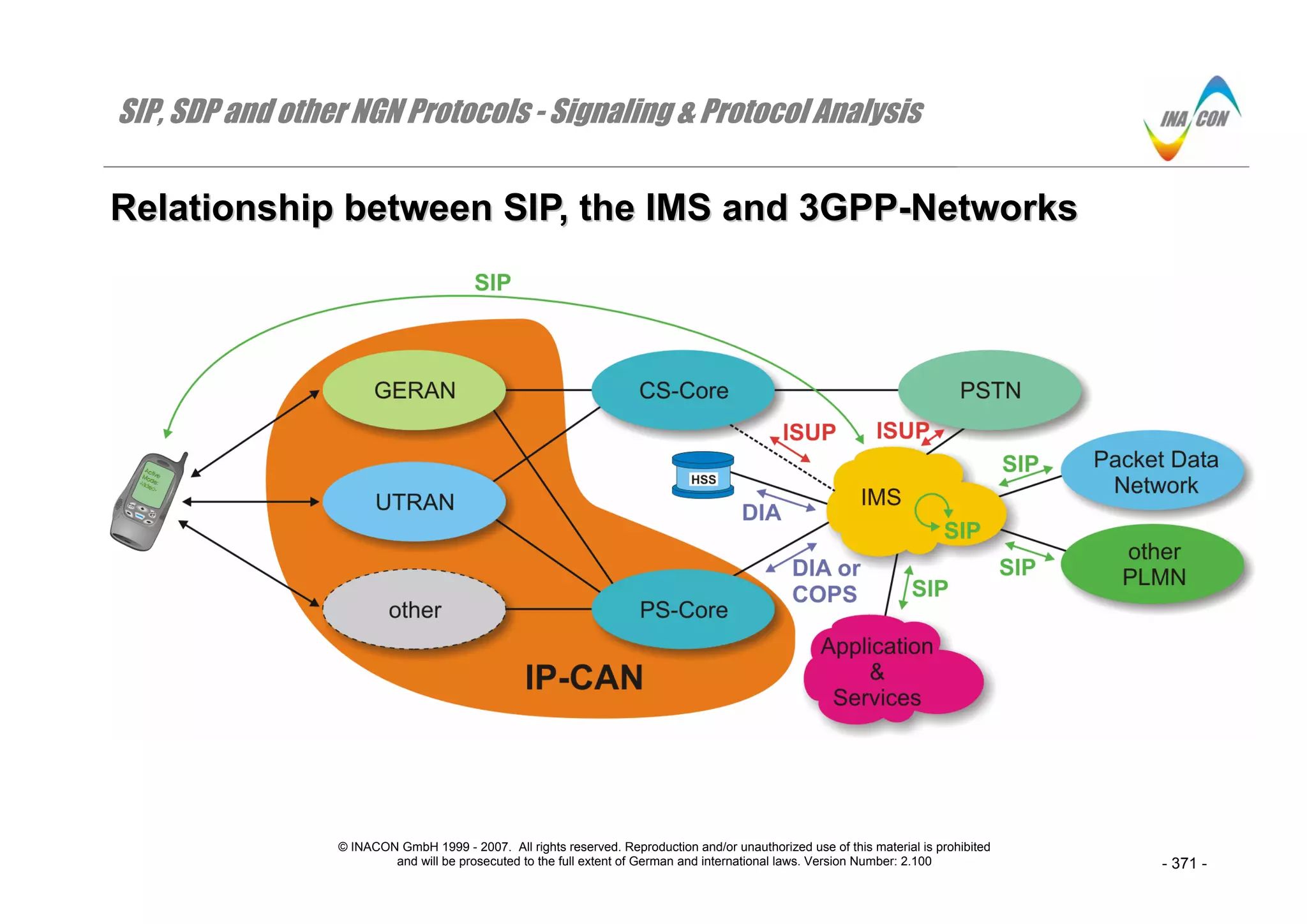
![SIP, SDP and other NGN Protocols - Signaling & Protocol Analysis
© INACON GmbH 1999 - 2007. All rights reserved. Reproduction and/or unauthorized use of this material is prohibited
and will be prosecuted to the full extent of German and international laws. Version Number: 2.100 - 372 -
RReellaattiioonnsshhiipp bbeettwweeeenn SSIIPP,, tthhee IIMMSS aanndd 33GGPPPP--NNeettwwoorrkkss
⇒ The figure illustrates how the IMS is interconnected to the various entities and network clouds that a 3GPP-network consists of or that a 3GPP-
network is connected to. For more details about the different logical entities within the IMS please refer to chapter 2 and to the course book “IMS –
Architecture Details & System Engineering”.
⇒ More importantly, the figure illustrates how the IMS communicates with these different entities and network clouds. Intentionally, we did not include
any notion of user data transfers to keep the illustration simple. Hence, the focus is purely on signaling.
⇒ Note that between the PS-Core ( or more precisely the GGSN) and the IMS ( or more precisely the P-CSCF) there may be a dedicated PDF
(Policy Decision Function) or the PDF may be integrated into the P-CSCF or it may be integrated into the GGSN. Depending on this configuration,
either COPS or DBP is used between the GGSN and the IMS for QoS-Policing [3GTS 23.228 (4.6.1), 3GTS 23.207 (5.1), 3GTS 29.209 (4.2)].
[3GTS 23.228]
???? Question Section 23 ????
⇒ In chapter 1 we stated explicitly that the IMS provides its services exclusively through the packet-switched domain. Why did we still need to insert the
dotted line between the IMS and the circuit-switched domain?](https://image.slidesharecdn.com/docfoc-160922051359/75/Docfoc-com-ngn-signaling-amp-amp-protocol-analysis-37-2048.jpg)